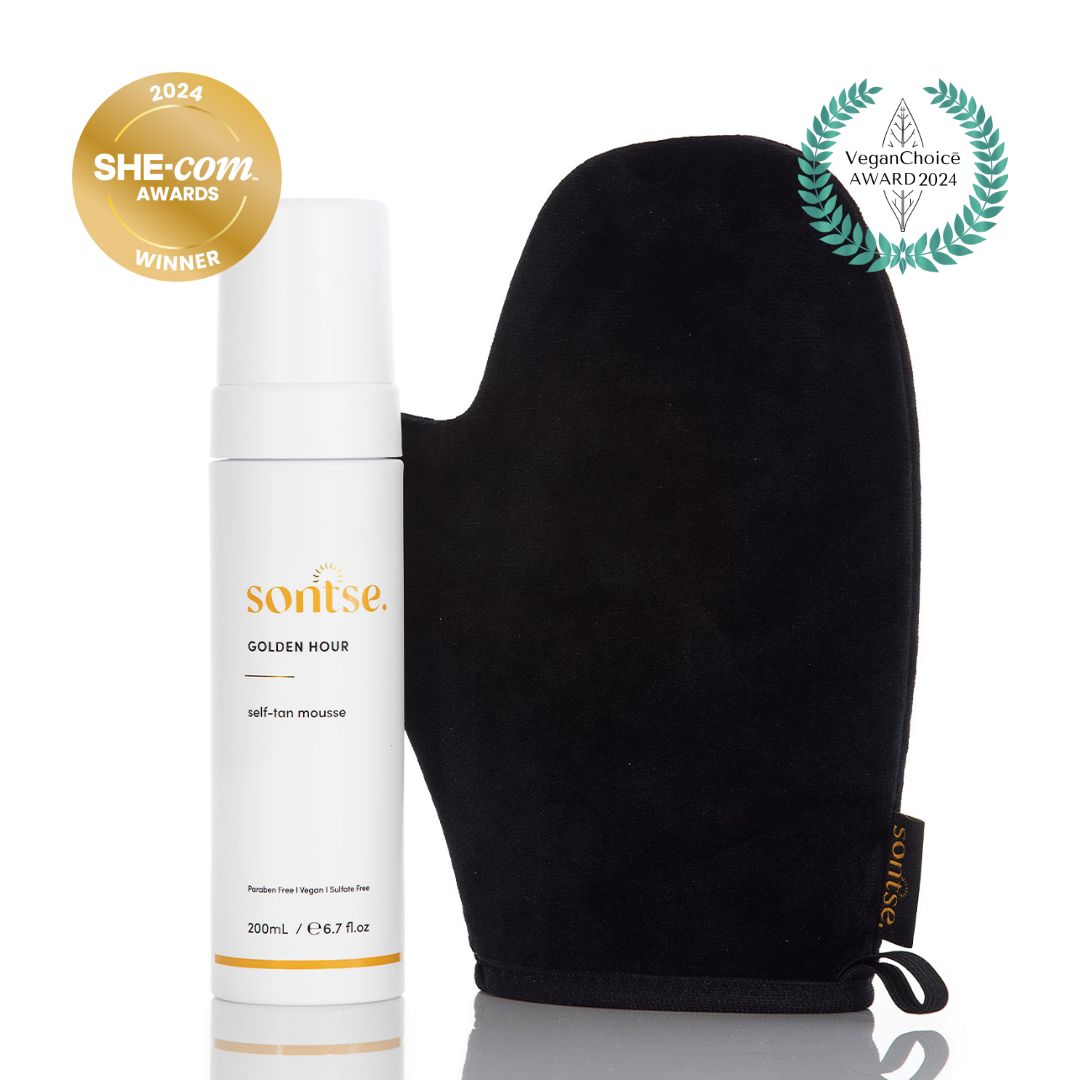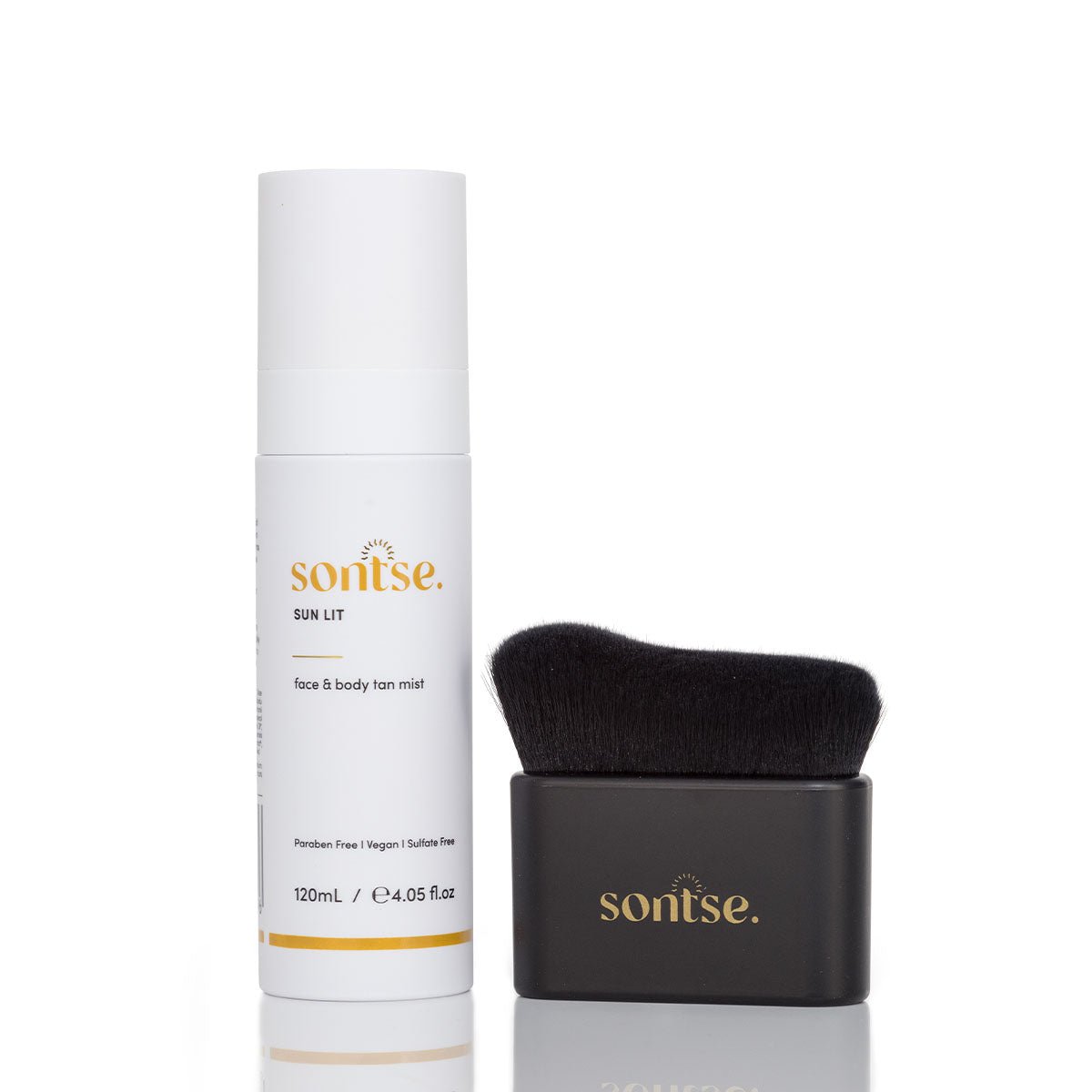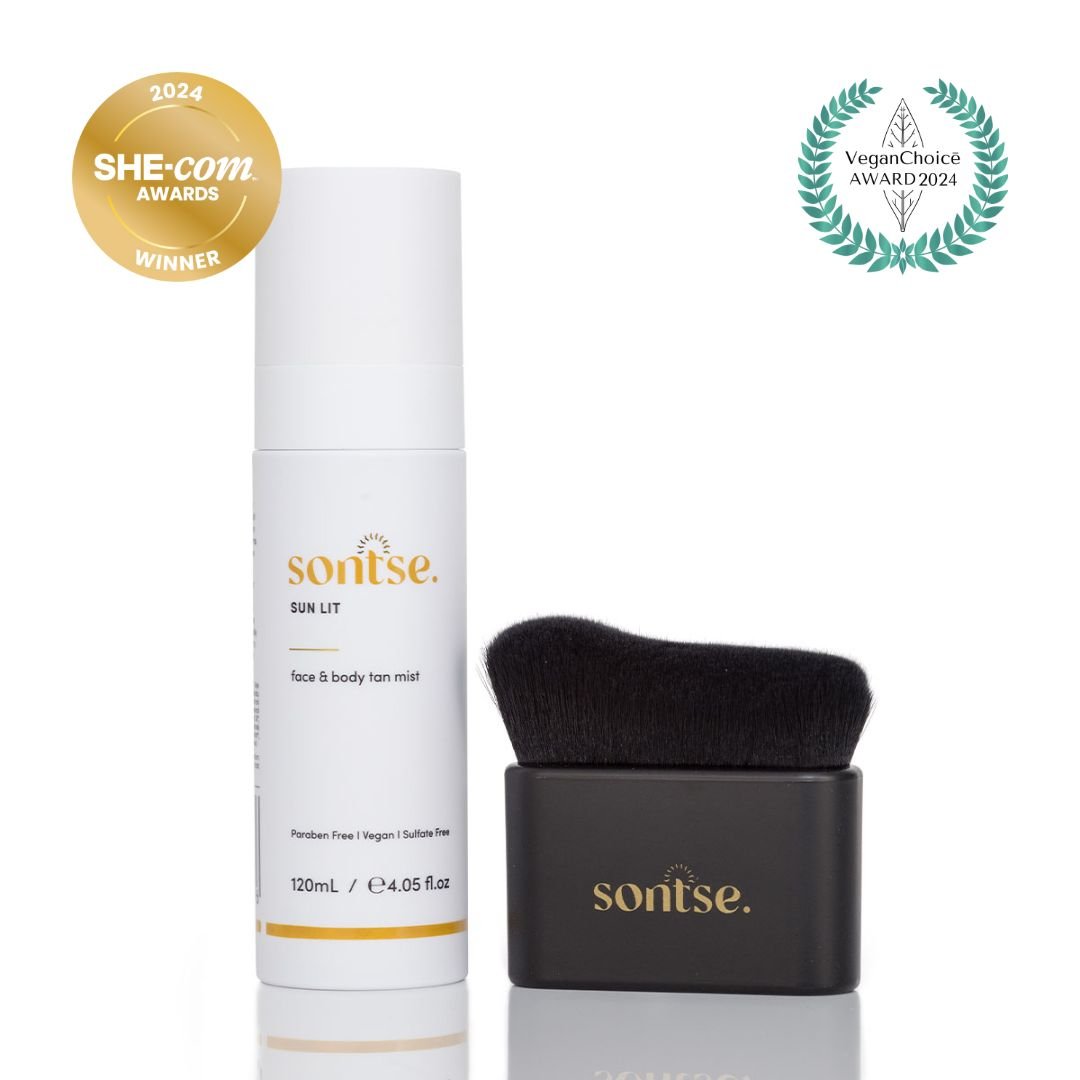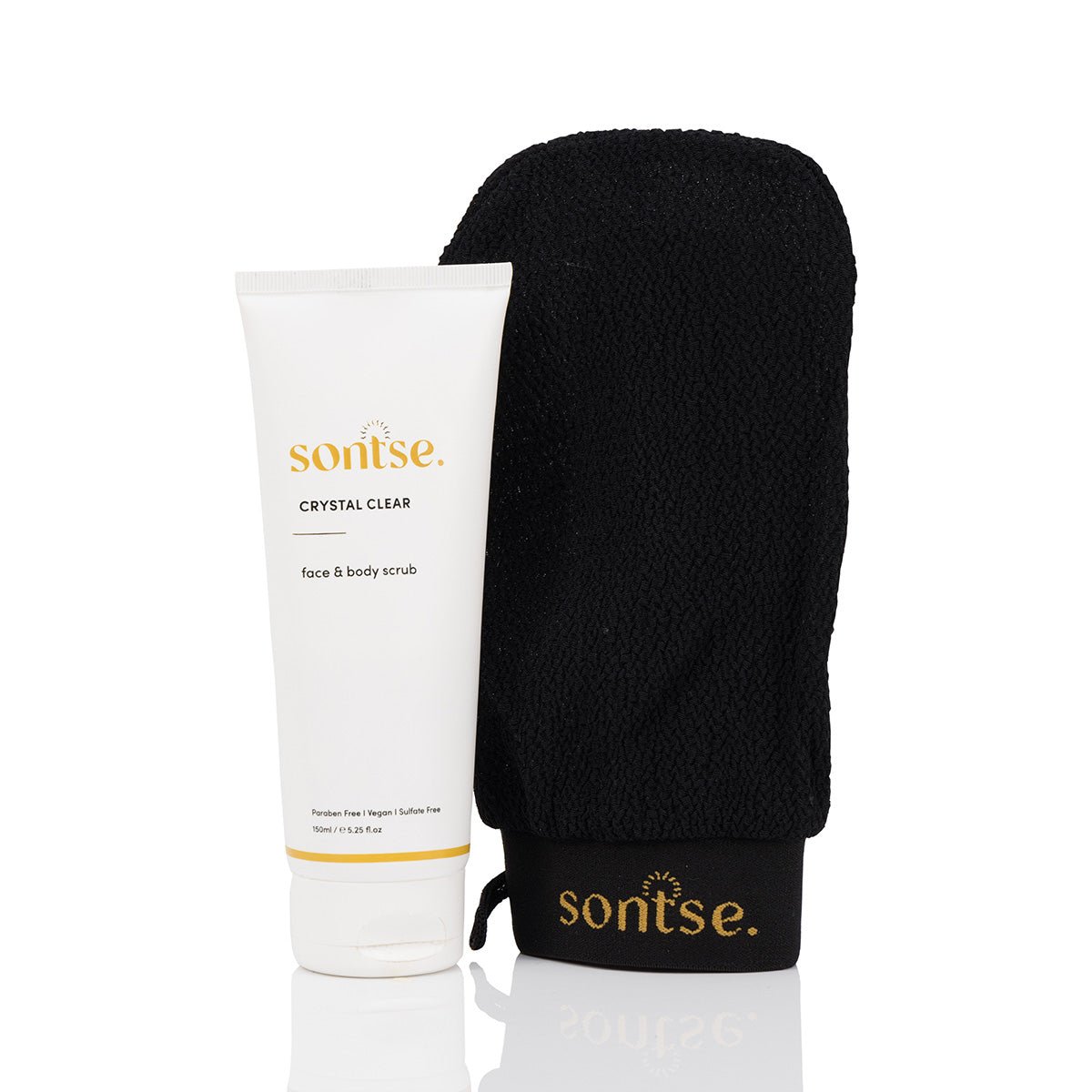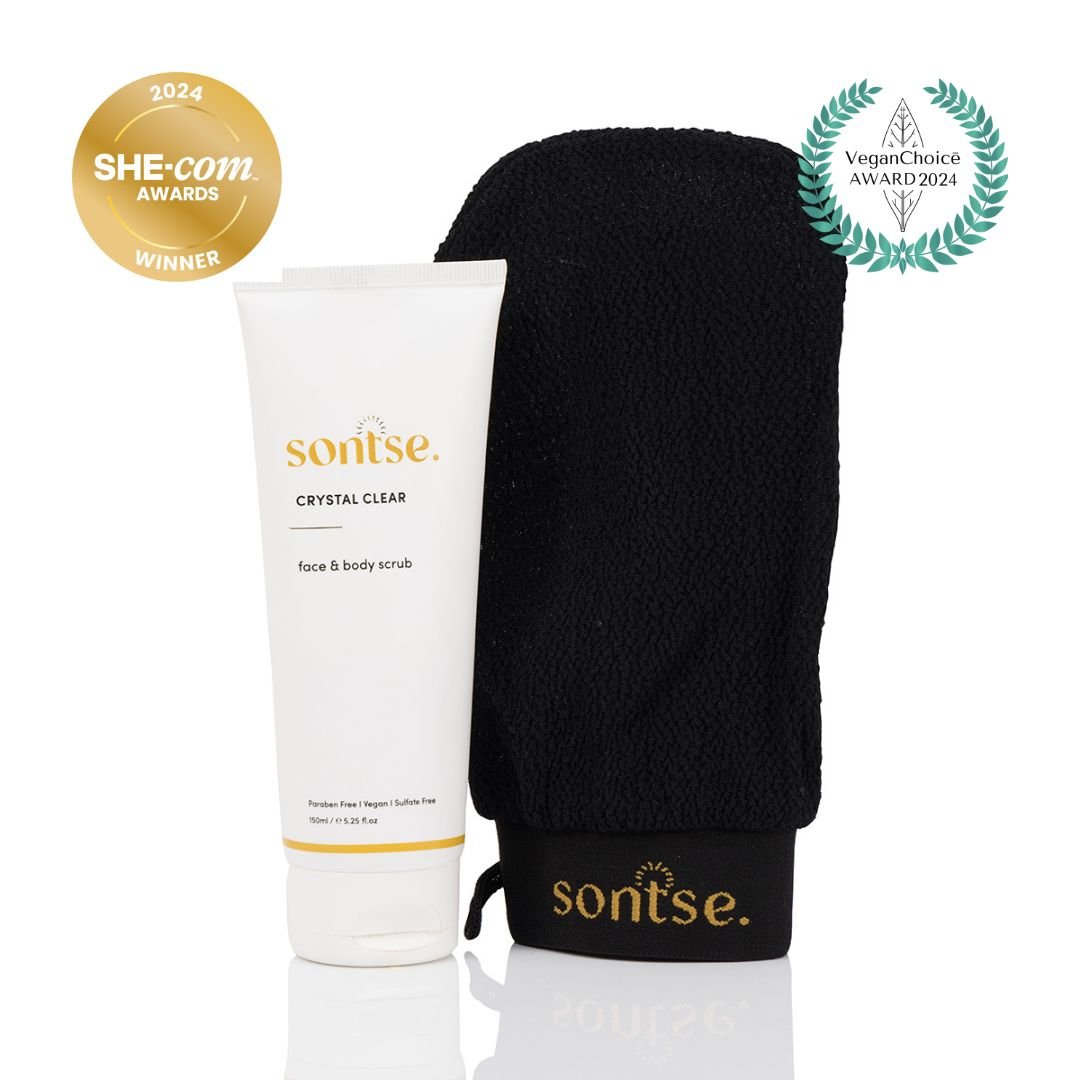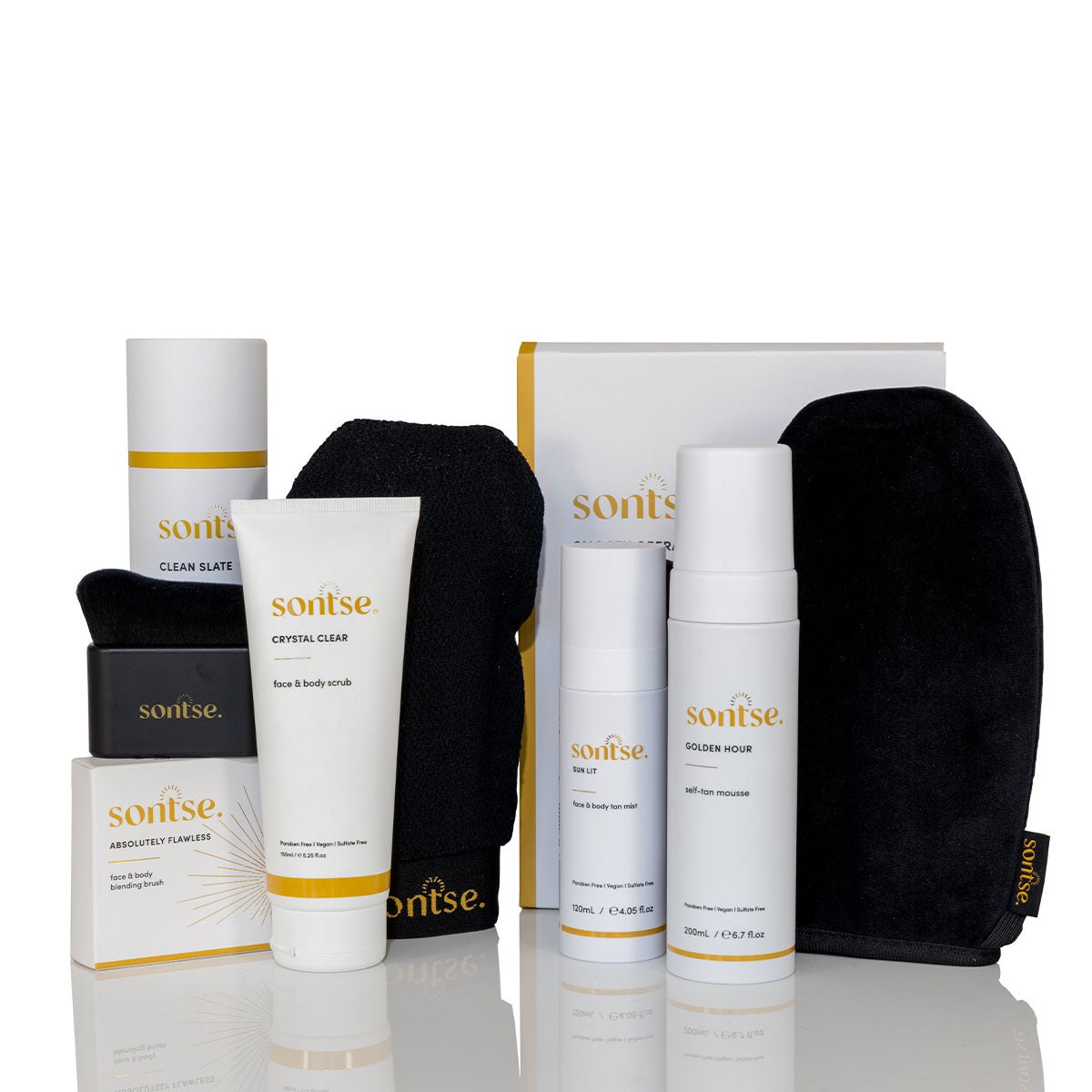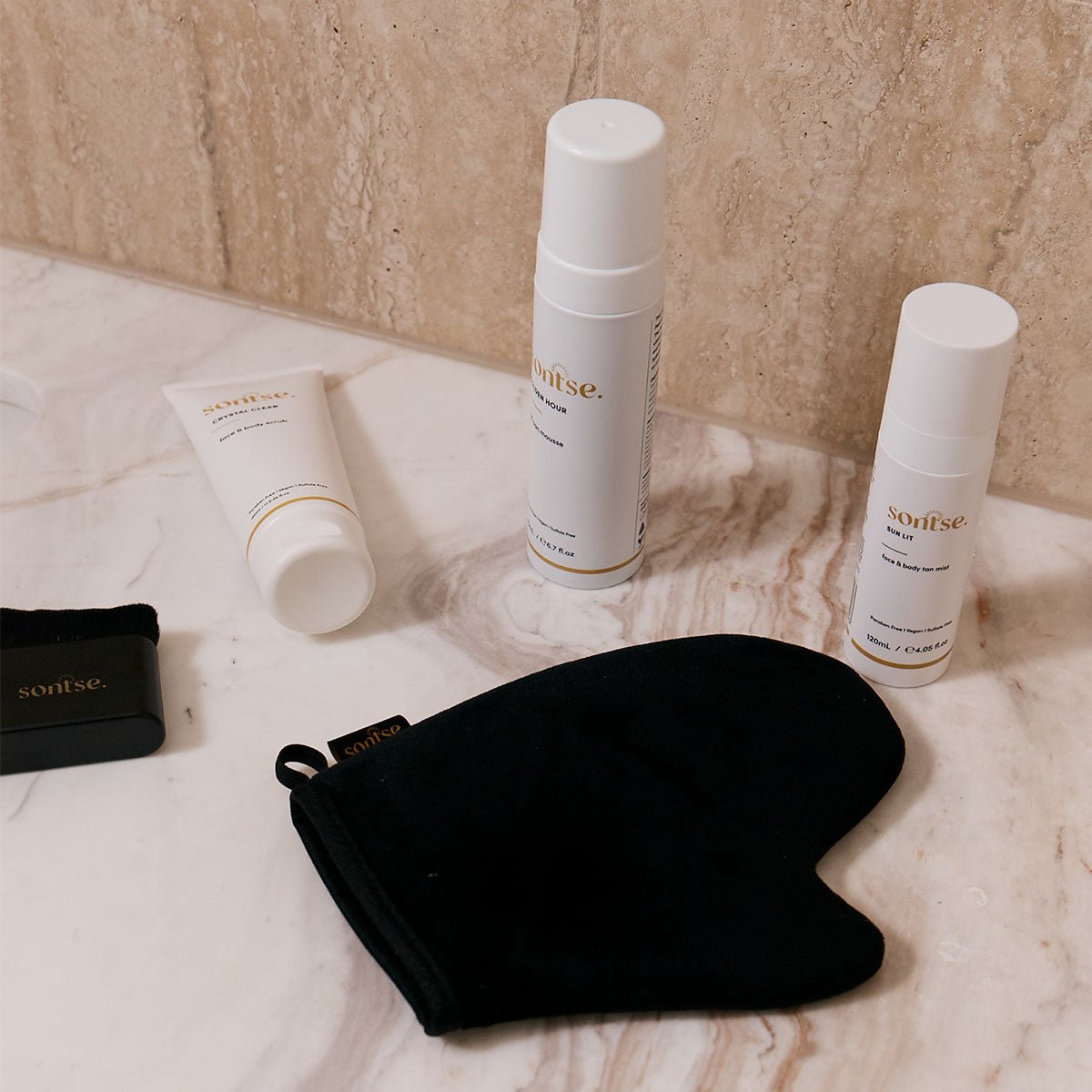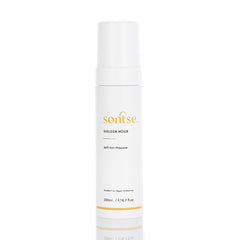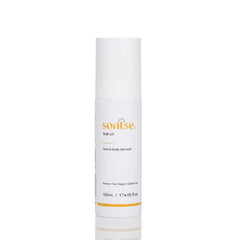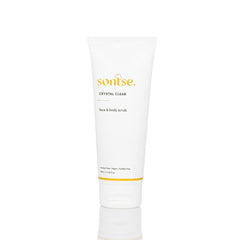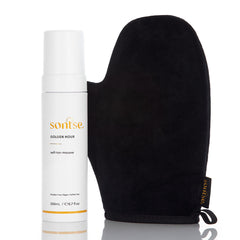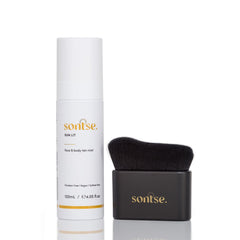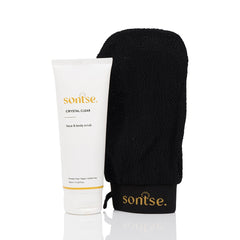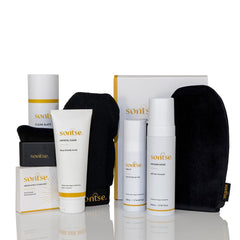Ever wondered what gives your sunless tan that gorgeous golden colour? The answer lies in three little letters: DHA.
If you're like most sun-conscious women, you've probably heard this term thrown around but never really understood what it means. And honestly, that's completely normal. Most of us just want to know our sunless tanning products work, that they’re safe on our skin, natural-looking, and that the application and removal will be as effortless as possible.
But here's the thing. Understanding DHA can help you choose better products and get that flawless glow you're after. So let's break it down in simple terms.
What Is DHA in Tanning?
DHA stands for dihydroxyacetone.
It's a colourless sugar. It can be manufactured synthetically or derived from glycerine and plant sources. When cosmetic chemists discovered it could bronze your skin without UV exposure, the sunless tanning industry was born.
Think of DHA as the colour controller. It's the active ingredient that does all the magic in your sunless tanning products. Whether you're using a mousse, mist, or lotion, self tan DHA is what's creating that sun-kissed look.
Here's something most people don't realise: DHA itself is completely clear and has no colour. The bronze tones you see in your tanning products? That comes from bronzers and colour guides that brands add so you can see where you're applying the product and get a sense of the colour depth you'll achieve.
What's reassuring is that DHA has been used safely in cosmetics since the 1960s (Gallagher, 2018). That's decades of women getting their glow without the sun damage by simply switching to dihydroxyacetone tanning.
How Does DHA Work in Self-Tanners?
Here's where it gets interesting. DHA doesn't actually tan your skin the way the sun does.
Instead, it reacts with amino acids in the top layer of your skin. This DHA tanning reaction creates brown compounds called melanoidins (Turner et al., 2023). These give you that bronzed appearance you love.
In general, the process can start working in as little as an hour for a subtle glow, with full development taking anywhere from 1-48 hours depending on the product, your skin tone and desired intensity. If using our Golden Hour Mousse (what we would consider an express tan), here's what actually works best:
- Super fair skin: 1-2 hours
- Medium to deeper skin tones: 2-3 hours
- Olive skin: 3-4 hours
For those using a gentle, gradual or daily face-specific self-tanner like our Sun Lit Face and Body Tan Mist - this is the kind of product you can leave on and allow to develop overnight or between that 1-8 hour mark before rinsing off the residue.
The beauty of quality Australian formulations is that they're so advanced, you really can't go wrong. They shouldn't go orange unless you're over-processing or leaving the tan on too long for your skin tone.
Your skin naturally sheds these outer cells every few days. That's why your sunless tan gradually fades. No permanent damage. No lasting effects. Just a temporary enhancement that works with your skin's natural renewal process.
DHA vs. Natural Tanning: What’s the Difference?
This is where choosing to go sunless really shines.
Natural tanning happens when UV rays penetrate deeper into your skin and trigger melanin production. Your body creates this pigment as a defence mechanism against sun damage. But here's what we know now that perhaps we didn't fully grasp in our teens and early twenties: that "healthy glow" comes with DNA damage, premature ageing, and increased skin cancer risk. You can learn more about that in our article Sunburn vs Tan: What's Really Happening To Your Skin.
DHA works completely differently. It only interacts with the very top layer of your skin. No UV exposure required. No cellular damage from the sun involved.
At this stage of life, when we're already thinking about preserving our skin's health and appearance for the long term, this distinction matters. One method protects your skin while giving you colour. The other accelerates the ageing process that we're already trying to manage with our best efforts.
Different Types of DHA in Self-Tanners
Not all DHA formulas are created equal. The concentration and additional ingredients can dramatically affect your results, but here's the thing: most brands are protective about disclosing exact DHA percentages, and honestly, as a consumer, what matters more is understanding the colour depth and how it compares to what you're trying to achieve.
Express tans are formulated with higher DHA concentrations for faster, deeper results. Think bridal-level colour that develops quickly without needing to sleep in your tan.
Gentle daily formulas contain lower DHA concentrations and are designed to be used as part of your regular skincare routine. These give you that subtle glow you can build gradually.
Face-specific formulas are typically much gentler. What we call "tanning water" or “tanning mist” - light-to-medium tans designed to give a soft glow that you can apply as your last skincare step before bed.
Your skin tone plays a huge role here. Fair skin responds beautifully to shorter processing times and gentler formulas. Medium skin tones can handle moderate concentrations. Deeper skin tones often need higher concentrations or longer processing times to see noticeable results.
So you can see why more isn't always better. It's about finding that sweet spot for your skin.
Potential Side Effects of DHA: Is DHA Safe?
The question we’re all wondering: Is DHA actually safe? And what are the DHA tanning side effects?
The good news: DHA has been approved by health authorities worldwide for cosmetic use. The FDA, TGA, and European agencies all consider it safe for external application with some posing some limitations on the quantity of DHA used in products (Ciriminna et al., 2018).
Most women experience zero side effects. But like any cosmetic ingredient, some people can be sensitive.
Possible reactions include:
- Mild skin irritation
- Temporary dryness
- Allergic reactions (rare)
- Skin dehydration
Here's something that's particularly relevant if you're in your 30s and 40s: DHA can be naturally dehydrating to the skin, and the longer you leave it on, the more dehydrating it becomes. As we age, our skin already produces less natural moisture, so this can be more noticeable for mature skin.
This is where choosing the right formula makes all the difference. Quality sunless tanners, like our Sontse collection, which is formulated with skincare in mind, combat this by packing our formulas with deeply hydrating ingredients. Think Vitamin E, Vitamin B5, Kakadu Plum extract, and nourishing oils like coconut and kiwi seed oil.
Also, a little something most people don't know: your skin actually absorbs all the skincare ingredients first before the DHA activates. This is why with our unique formulations at Sontse, you're actually getting a little skincare treatment and a tan simultaneously.
The result? Your sunless tan actually becomes part of your skincare routine rather than working against it. You wake up with gorgeously bronzed skin that feels soft, dewy, and actually more hydrated than before you applied it.
Bringing it all together: Jayde’s personal approach to creating the perfect formula
“When I was formulating this, I used to use multiple different products. Some had a colour I loved, but would wear off after two days. Others would crack my skin because they weren’t hydrating enough. So I really wanted to counteract the drying effect of DHA by adding skincare-based ingredients that nourish the skin.” - Jayde Houndalas, Founder of Sontse.
Important considerations for DHA use
1. If you're undergoing cancer treatment or taking medications like Roaccutane, this can affect how your tan develops. Always run any beauty product ingredients past your oncologist or GP if you're pregnant or undergoing medical treatments.
2. Also, interactions between different beauty products can affect how your tan wears. People often assume a product "didn't work" when there could be several external factors at play.
3. While we can't speak for all formulations out there, if you have sensitive skin, patch test first. Apply a small amount to your inner wrist and wait 24 hours. No reaction? You're good to go.
4. Although it goes without saying, always remember DHA is only safe for external use. Never use sunless tanning products near your eyes, mouth, or nose.
5. And finally, in this article specifically, we’ve looked a little deeper into what is DHA in tanning lotions and whether DHA for tanning is safe for your body. For those wondering what is DHA in spray tan and whether professional spray tan DHA side effects are different, we highly recommend speaking with the salon you are visiting. Remember no two formulas are the same, and with a spray tan, the added concern of inhalation may pose unique concerns for you.
At a bare minimum, requesting to know the quality of the self tanner being used in their machines is a must.
If you’re looking for a skin-conscious salon that uses our clean, non-toxic sunless tanner, you can explore some of our stockists here.
DHA for Tanning: Choosing the Right Concentration
Getting this right makes the difference between looking naturally sun-kissed and looking overdone.
Light, buildable colour: Perfect if you're naturally pale, new to sunless tanning, or want something you can use regularly as part of your skincare routine. At Sontse our self-tanning mist is the kind of product you’ll want to add to your cart.
Medium, natural bronze: This is the sweet spot for most women. Beautiful colour that develops in a few hours and looks completely believable.
Deep, express results: If you want that just-back-from-holidays glow quickly, look for express formulations designed for faster, deeper colour development.
Our self tan mousse is perfect for all three, light, medium and deep express results. You literally tailor the colour depending on how long you leave it on. We usually say between 1-4 hours.
Remember, you can always build colour gradually. It's much easier to add more than to tone down later.
Does DHA in Tanning Smell? How to Minimise the Fake Tan Odour
Ah, the dreaded sunless tan smell. If you've been sunless tanning for years, you know exactly what we're talking about. And if you're new to it, this is probably one of your biggest concerns.
Here's a myth-busting moment: that distinctive sunless tan smell? That's actually the DHA itself reacting with your skin. It's not an added ingredient or a sign that something's wrong, it's just the natural result of the tanning process.
In general, the smell usually appears a few hours after application and can last 24-48 hours. When you're heading to work meetings or events, the last thing you want is to smell like you've been wrestling with a bottle of sunless tan.
At Sontse, we formulated our sunless tanner with the understanding that most women don't have 12 hours up their sleeve to simply stay put at home before heading out. Which is why our formulas are fast-drying and designed for shorter processing times.
But here's where ingredient choice matters: instead of using synthetic fragrance (which often contains harsh chemicals that brands don't have to disclose and can be hormone disruptors), we used plant-based ingredients to create our scent. The result? A subtle hint of coconut and roses that actually smells gorgeous while your tan develops.
Some other tips for reducing the DHA smell:
Shower properly: Use lukewarm water and a gentle body wash when rinsing off. This removes excess DHA that hasn't been absorbed.
Exfoliate beforehand: Dead skin cells can trap DHA and increase odour. A good scrub before application helps.
Stay hydrated: Well-moisturised skin processes DHA more efficiently, reducing smell.
How to Apply DHA-Based Self-Tanners for the Best Results
Getting flawless results doesn't require hours of your time or professional techniques. But it does require the right approach and a little patience.
Step 1: Be Prepared
A gorgeous, long-lasting tan begins with proper prep. While it's tempting to skip ahead to the glow, this step is non-negotiable.
Start by gently exfoliating your skin 24 hours before tanning. Use a gentle scrub to sweep away dead cells and any lingering body products that could interfere with smooth, even colour. Pair this with an exfoliating mitt. Think of it as an essential tool in your tanning ritual.
Step 2: Cover Your Bases
Apply your sunless tanner to clean, completely dry skin. Work in sections using circular motions, starting with your legs and moving up. If you're using a mousse, a velvet tanning mitt prevents stained palms and gives you better coverage.
Build colour gradually rather than applying thick layers. Your skin will thank you for the patience.
Here's something worth noting: if you're using a hydrating formula packed with skin-loving ingredients, you might actually find your skin feels more moisturised after application. That's the beauty of choosing sunless tanners that double as skincare, especially important as our skin needs more TLC as we age.
Step 3: Smooth Things Over
This is where the magic happens. Use a face and body blending brush to target those hard-to-reach or often-missed areas. Gently buff a small amount of product onto clean skin using soft, circular motions.
For delicate areas like your face and décolletage, opt for a lightweight tan mist that works like tanning water. Apply sparingly as your last skincare step, let it settle, then blend using a kabuki brush if needed. This technique gives you complete colour control and can be part of your nightly routine.
Don't forget to lightly apply to the tops of your hands, elbows, and feet for a perfectly polished look.
Step 4: Wait for the Glow
Leave your tan to develop based on your skin tone and desired result – anywhere from 1 hour for a subtle glow to 4 hours for deeper colour. Once you've reached your desired shade, rinse with lukewarm water to reveal your true colour.
Step 5: Practice Safe Sun Exposure
It’s something most sunless tanning brands won't tell you, but we're passionate about this step especially.
Just because you have a gorgeous tan doesn't mean you can skip sun protection.
Protecting your skin doesn't have to be complicated, but it is essential. Wear UV protective clothing, apply broad-spectrum sunscreen, choose sunglasses, and seek shelter when the UV index is high.
These simple habits significantly reduce your risk of UV damage while keeping your skin healthy and radiant for years to come.
So there it is, our comprehensive answer to ‘What is DHA tanning?’. No matter what brought you here, we hope that understanding DHA really helps you with making more informed choices for your skin.
No matter what product you feel aligns most with you, the beautiful thing to remember is that when you choose sunless tanning over UV exposure, you're choosing long-term skin health. You're modelling sun-conscious behaviour for the next generation. And you're proving that being conscious of how you choose to glow is both elegant and essential.
The best tan is the one that keeps your skin healthy while giving you that confidence boost you're after. DHA makes that possible. And when it's added to a formula made thoughtfully with care, it can actually improve your skin while giving you that gorgeous glow. Come explore our conscious collection of sunless tanning products and discover a better kind of bronze today.
References
Ciriminna, R., Fidalgo, A., Ilharco, L., & Pagliaro, M. (2018, March 6). ChemistryOpen. Dihydroxyacetone: An Updated Insight into an Important Bioproduct. Retrieved June 25, 2025, from https://pmc.ncbi.nlm.nih.gov/articles/PMC5838383/
Gallagher, M. (2018). Exposure to Dihydroxyacetone in Sunless Tanning Products. Journal of the Dermatology Nurses’ Association, 10(1), 11-17. DOI: 10.1097/JDN.0000000000000366
Turner, J., O’Loughlin, D. A., Green, P., McDonald, T. O., & Hamill, K. J. (2023, Jan). In search of the perfect tan: Chemical activity, biological effects, business considerations, and consumer implications of dihydroxyacetone sunless tanning products. J Cosmet Dermatol, 22(1), 79-88. doi: 10.1111/jocd.14968


